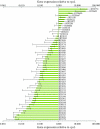Characterization of Sec-translocon-dependent extracytoplasmic proteins of Rickettsia typhi
- PMID: 18641131
- PMCID: PMC2546805
- DOI: 10.1128/JB.00794-08
Characterization of Sec-translocon-dependent extracytoplasmic proteins of Rickettsia typhi
Abstract
As obligate intracellular, vector-borne bacteria, rickettsiae must adapt to both mammalian and arthropod host cell environments. Deciphering the molecular mechanisms of the interactions between rickettsiae and their host cells has largely been hindered by the genetic intractability of these organisms; however, research in other gram-negative pathogens has demonstrated that many bacterial determinants of attachment, entry, and pathogenesis are extracytoplasmic proteins. The annotations of several rickettsial genomes indicate the presence of homologs of the Sec translocon, the major route for bacterial protein secretion from the cytoplasm. For Rickettsia typhi, the etiologic agent of murine typhus, homologs of the Sec-translocon-associated proteins LepB, SecA, and LspA have been functionally characterized; therefore, the R. typhi Sec apparatus represents a mechanism for the secretion of rickettsial proteins, including virulence factors, into the extracytoplasmic environment. Our objective was to characterize such Sec-dependent R. typhi proteins in the context of a mammalian host cell infection. By using the web-based programs LipoP, SignalP, and Phobius, a total of 191 R. typhi proteins were predicted to contain signal peptides targeting them to the Sec translocon. Of these putative signal peptides, 102 were tested in an Escherichia coli-based alkaline phosphatase (PhoA) gene fusion system. Eighty-four of these candidates exhibited signal peptide activity in E. coli, and transcriptional analysis indicated that at least 54 of the R. typhi extracytoplasmic proteins undergo active gene expression during infections of HeLa cells. This work highlights a number of interesting proteins possibly involved in rickettsial growth and virulence in mammalian cells.
Figures


References
-
- Alto, N. M. 2008. Mimicking small G-proteins: an emerging theme from the bacterial virulence arsenal. Cell Microbiol. 10566-575. - PubMed
-
- Anderson, B. E. 1990. The 17-kilodalton protein antigens of spotted fever and typhus group rickettsiae. Ann. N. Y. Acad. Sci. 590326-333. - PubMed
-
- Backert, S., and T. F. Meyer. 2006. Type IV secretion systems and their effectors in bacterial pathogenesis. Curr. Opin. Microbiol. 9207-217. - PubMed
-
- Bendtsen, J. D., H. Nielsen, G. Von Heijne, and S. Brunak. 2004. Improved prediction of signal peptides: SignalP 3.0. J. Mol. Biol. 340783-795. - PubMed
-
- Bina, J. E., F. Nano, and R. E. Hancock. 1997. Utilization of alkaline phosphatase fusions to identify secreted proteins, including potential efflux proteins and virulence factors from Helicobacter pylori. FEMS Microbiol. Lett. 14863-68. - PubMed
Publication types
MeSH terms
Substances
Grants and funding
LinkOut - more resources
Full Text Sources
Research Materials

